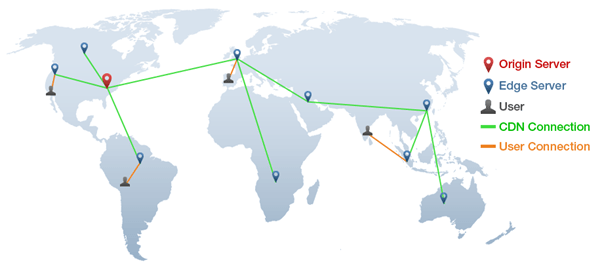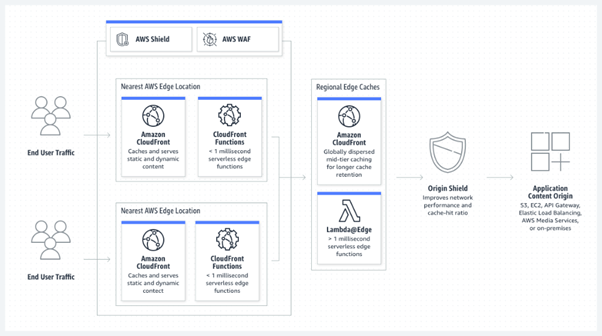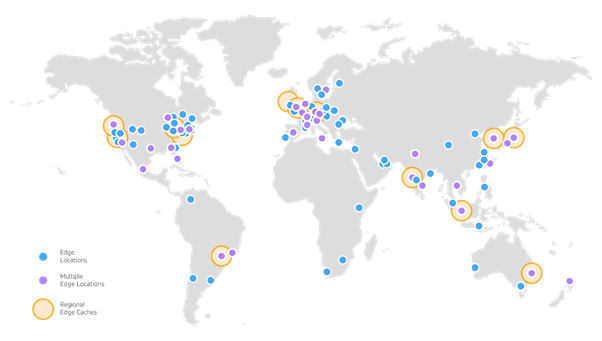Optimizing Web Performance – The Power and Advantages of Content Delivery Networks (CDNs)
Publish Date: December 22, 2023A Content Delivery Network (CDN) is like a global team of specialized servers, each playing a crucial role in delivering various types of content, such as text, images, videos, and scripts, to users all over the world. These servers, known as Edge Servers, act as strategic caches for frequently accessed resources, such as images, CSS/JS files, and structural components.
By having multiple servers spread out geographically, CDNs can significantly reduce page load times for end-users. In other words, CDNs work by providing multiple server nodes in different locations for users to download resources from, especially for static content like images and JavaScript. These strategically placed nodes are spread throughout the world, bringing them closer to users and ensuring faster responses. This means your website will load faster for your users, providing a smoother and more efficient browsing experience.
Think of a CDN as an ATM network strategically placed around the world. This orchestration of servers eliminates the digital traffic jams, providing users with immediate access to web content, much like accessing cash from conveniently located ATMs.
Getting content from centrally located servers to individual users simply took too long. CDNs have now grown to include everything from text, graphics, scripts, and media files to software downloads, documents, portals, e-commerce, live streaming media, on-demand video streaming media, and social media sites.
Why is CDN Essential: Crafting Better Experiences
The majority of an end user’s page load time is spent on retrieving content, so it makes sense to provide these “building blocks” of a site in as many server nodes as possible.
When a user requests your site, the node closest in proximity to the user will deliver the static content, ensuring the shortest distance for the data to travel (reduced latency), therefore providing the fastest site experience.

Advantages of Using a CDN
Efficient Server Load Management: CDN’s distributed architecture prevents server overload, enhancing overall capacity, and reducing bandwidth and delivery costs.
Swift Website Speed and Performance: By delivering content from the nearest server, CDNs minimize user wait times, significantly improving web performance and response times.
Strategic Audience Segmentation with User Analytics: Real-time analytics empowers businesses to optimize websites, enhancing user experience and contributing to increased sales and conversions.
Packet Loss and Latency Reduction: CDNs mitigate packet loss, lower network latency, and ensure optimal user experiences, especially for high-definition content.
Advanced Website Security: CDN’s robust infrastructure protects against DDoS attacks, ensuring uninterrupted website availability and safeguarding against economic losses and reputation damage.
Content Availability Enhancement: CDNs absorb and distribute traffic, ensuring uninterrupted service even if a server goes down, contributing to enhanced content availability.
Cost Savings through Bandwidth Reduction: CDNs efficiently manage bandwidth, reducing web hosting costs and ensuring optimal performance during high-traffic periods.
Global Reach and Effective Scaling: CDNs facilitate cost-effective content delivery to geographically distant users, providing a consistent user experience and accelerating audience expansion.
Swift Content Delivery: Reduced latency through CDN servers physically closer to users ensures swift content delivery.
Redundancy and Reliability: CDNs offer redundancy and high availability by replicating content across multiple servers globally.
DDoS Mitigation: Integrated DDoS protection features in CDNs filter out malicious traffic, ensuring web resource availability.
Business Sectors Empowered by CDNs:
CDNs have proven to be the primary backbone for a multitude of industries, greatly impacting their day-to-day processes and interactions with their audiences. From facilitating online transactions in E-commerce to transforming the landscape of Education, CDNs serve as a fundamental component in elevating user experiences and ensuring uninterrupted connectivity. In vital areas such as Media and Entertainment and Online Gaming, CDNs are essential for streamlining content delivery to a global audience. Additionally, SaaS (Software as a Service) Providers heavily rely on CDNs in order to provide efficient and dependable services, while the Financial Services sector benefits from the efficient delivery of data and secure transactions. Furthermore, even within Government and Public Sector operations, CDNs play a critical role by enhancing accessibility and distributing data seamlessly.
Healthcare and Telemedicine find support in CDNs for swift and secure information exchange. Advertising and Marketing strategies are enhanced through better and faster content delivery, and the Travel and Hospitality sector relies on CDNs for a seamless online presence.
Amazon CloudFront
Amazon CloudFront, a pinnacle CDN service by Amazon Web Services (AWS), is designed for high performance, security, and developer convenience. From global dispersion to security enhancements, CloudFront is a versatile solution for elevating web applications and content delivery.
You can use Amazon CloudFront to do these tasks:
- Deliver data through 450+ globally dispersed points of presence (POPs) with automated network mapping and intelligent routing.
- Improve security with traffic encryption and access controls, and use AWS Shield Standard to defend against distributed denial-of-service (DDoS) attacks at no additional charge.
- Customize the code you run at the AWS network edge using serverless compute features to balance cost, performance, and security.
- Scale automatically to deliver software, game patches, and IoT updates with high transfer rates.
- Security: Enhance security for our content and applications by using CloudFront’s features, including SSL/TLS encryption, access control, and integration with AWS Web Application Firewall (WAF) for protection against DDoS attacks and web application threats.
- API Acceleration: Improve the performance of RESTful APIs and web services by routing API requests through CloudFront, reducing latency and enhancing scalability.
- Edge Compute: Execute serverless code and serverless applications at the edge using AWS Lambda@Edge in combination with CloudFront to perform tasks like A/B testing, real-time image optimization, and header manipulation.
- Geo-Blocking: Restrict or allow access to your content based on the geographic location of users by using CloudFront’s geo-blocking features.
How CloudFront Works?
Amazon CloudFront is a content delivery network (CDN) service offered by Amazon Web Services (AWS) designed to distribute content quickly, securely, and efficiently to users across the globe.
CloudFront delivers content through a worldwide network of data centers called edge locations. When a user requests content that you’re serving with CloudFront, the request is routed to the edge location that provides the lowest latency (time delay), so that content is delivered with the best possible performance.

Source: https://aws.amazon.com/cloudfront/
AWS CloudFront Global Edge Locations:
To deliver content to end users with lower latency, Amazon CloudFront uses a global network of 550+ Points of Presence and 13 regional edge caches in 100+ cities across 50 countries. Amazon CloudFront Edge locations are located in:

These networks not only optimize content but also ensure secure data transmission, delivering protected digital experiences to users. The journey forward is clear – in a world driven by digital content, CDNs have become indispensable in driving online engagement and business efficacy.
















